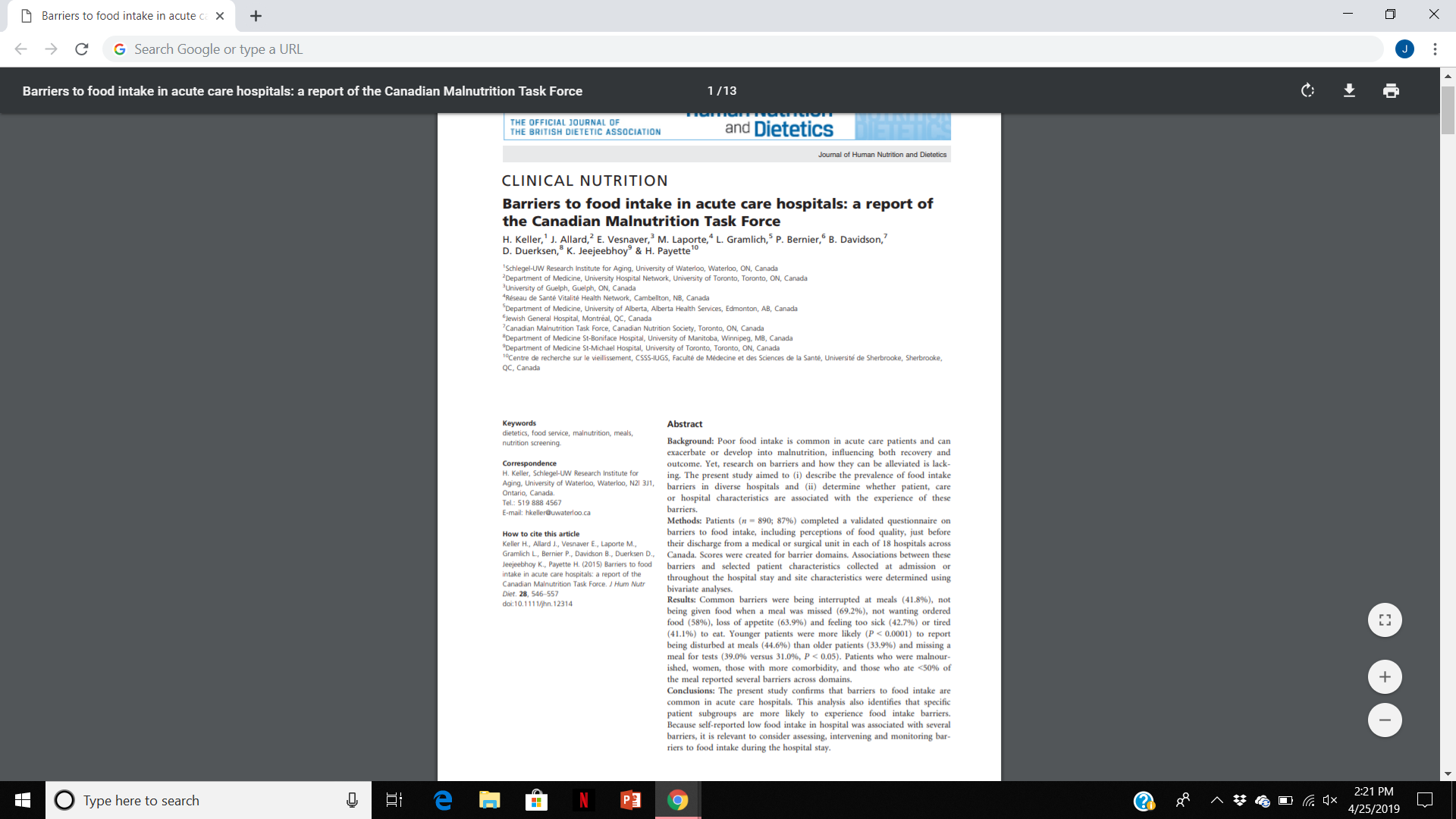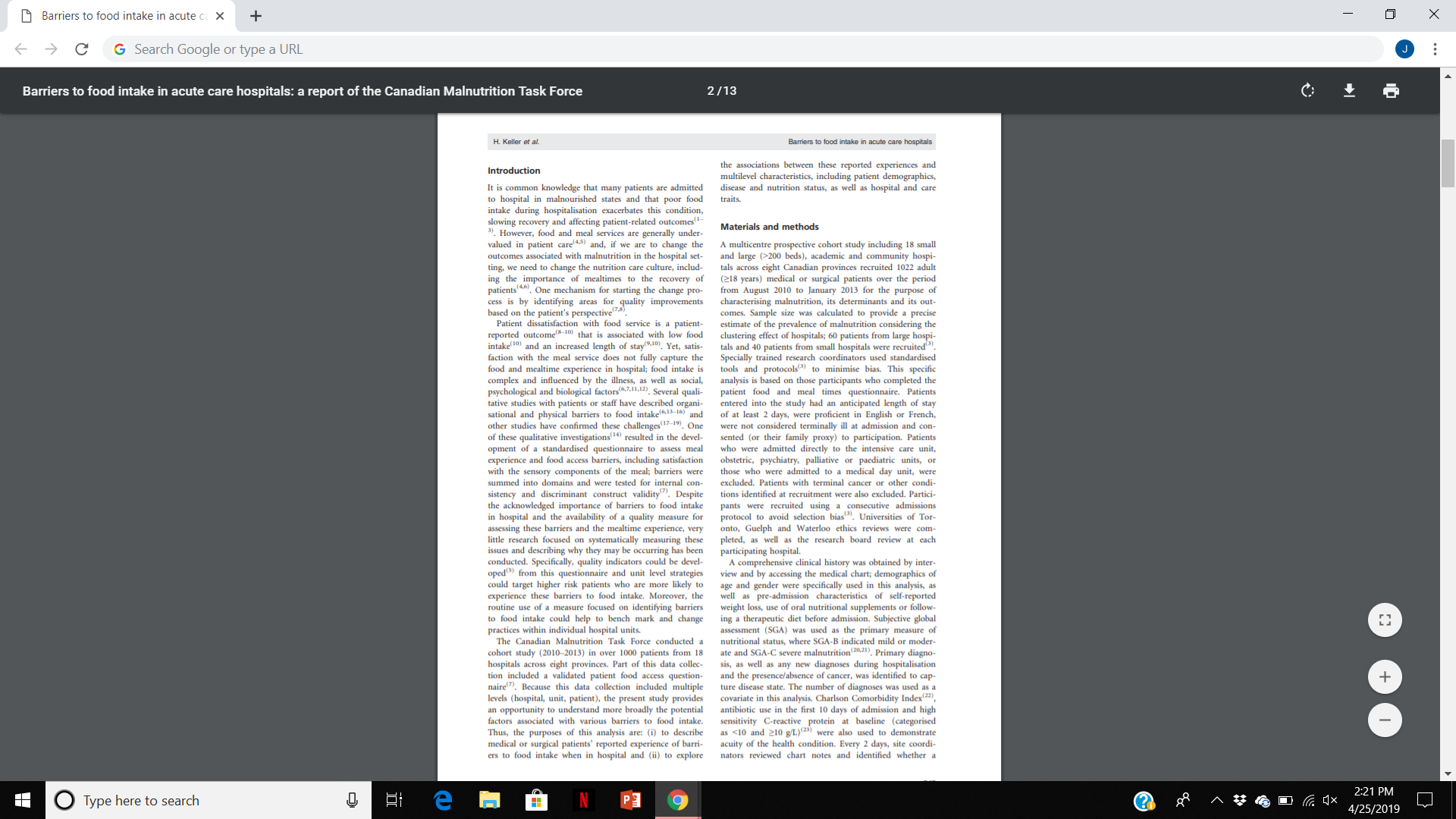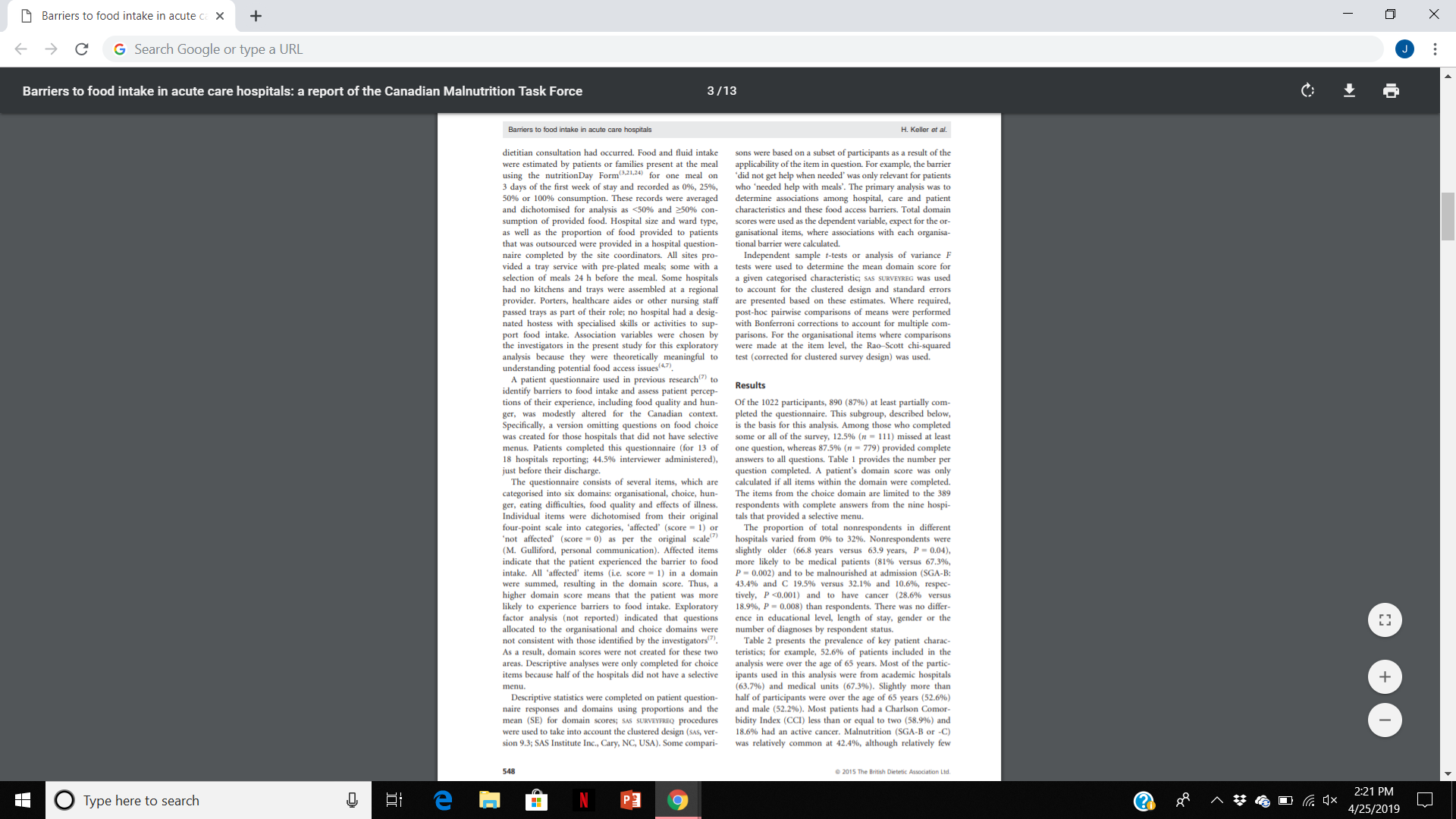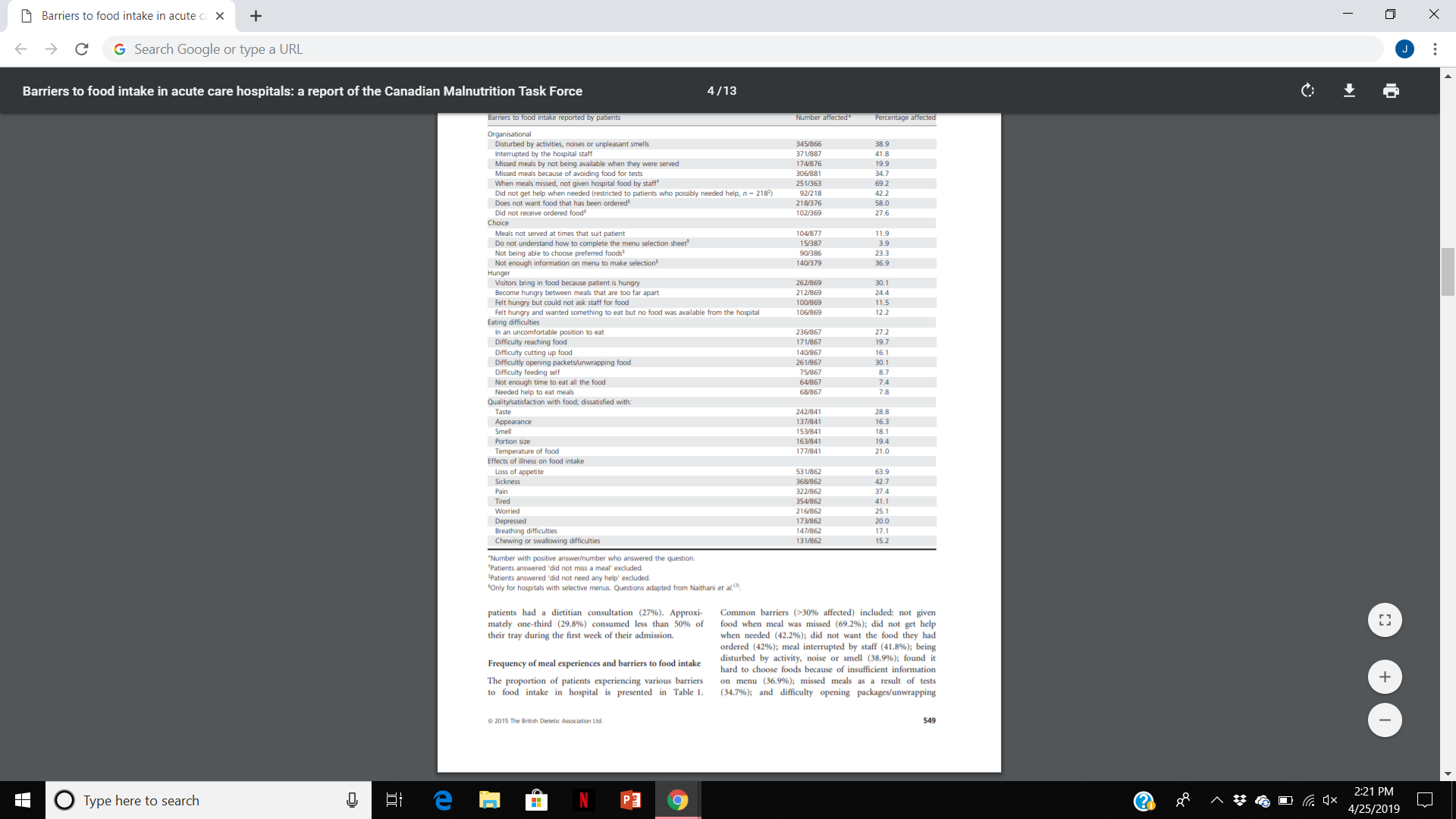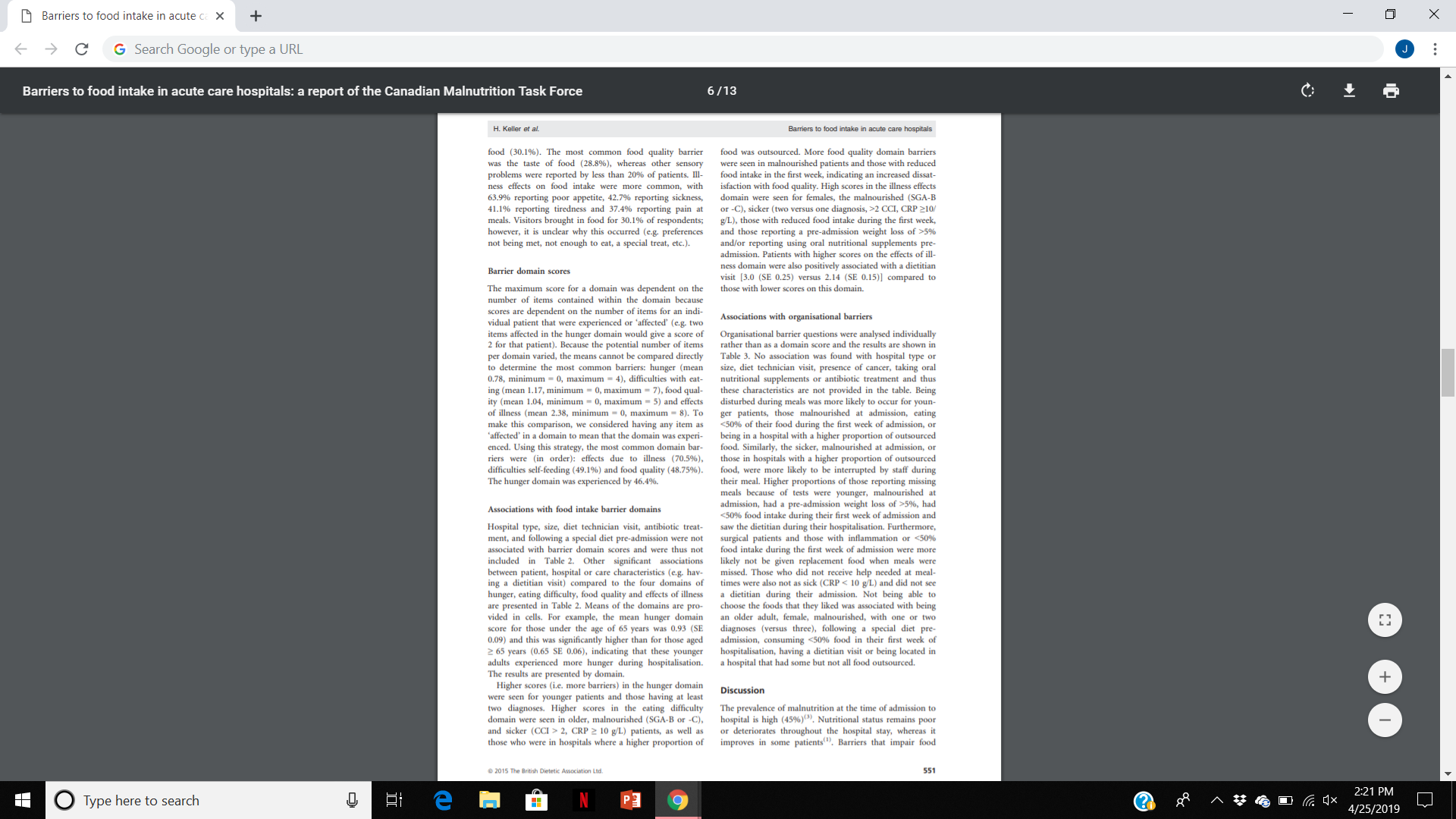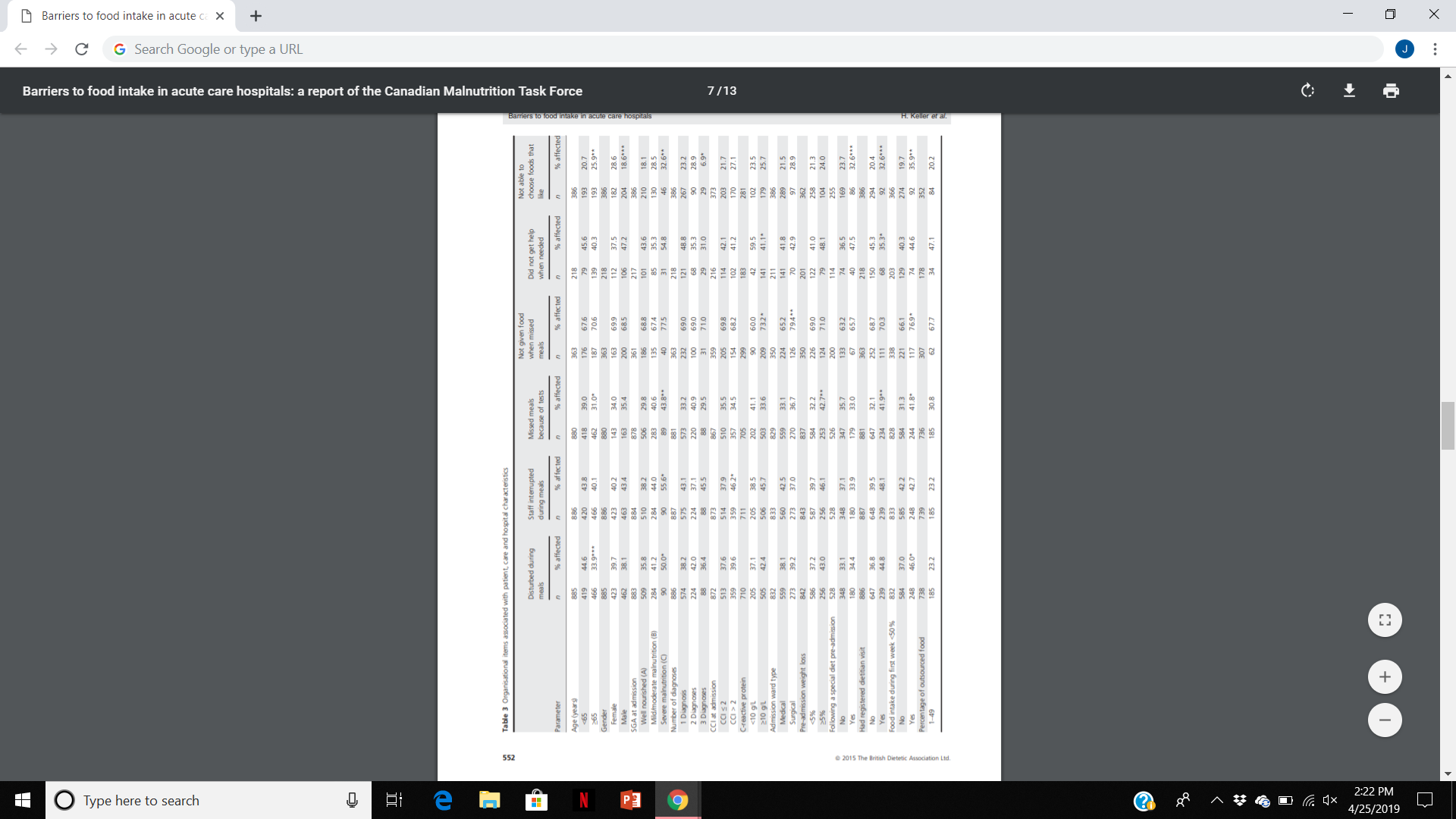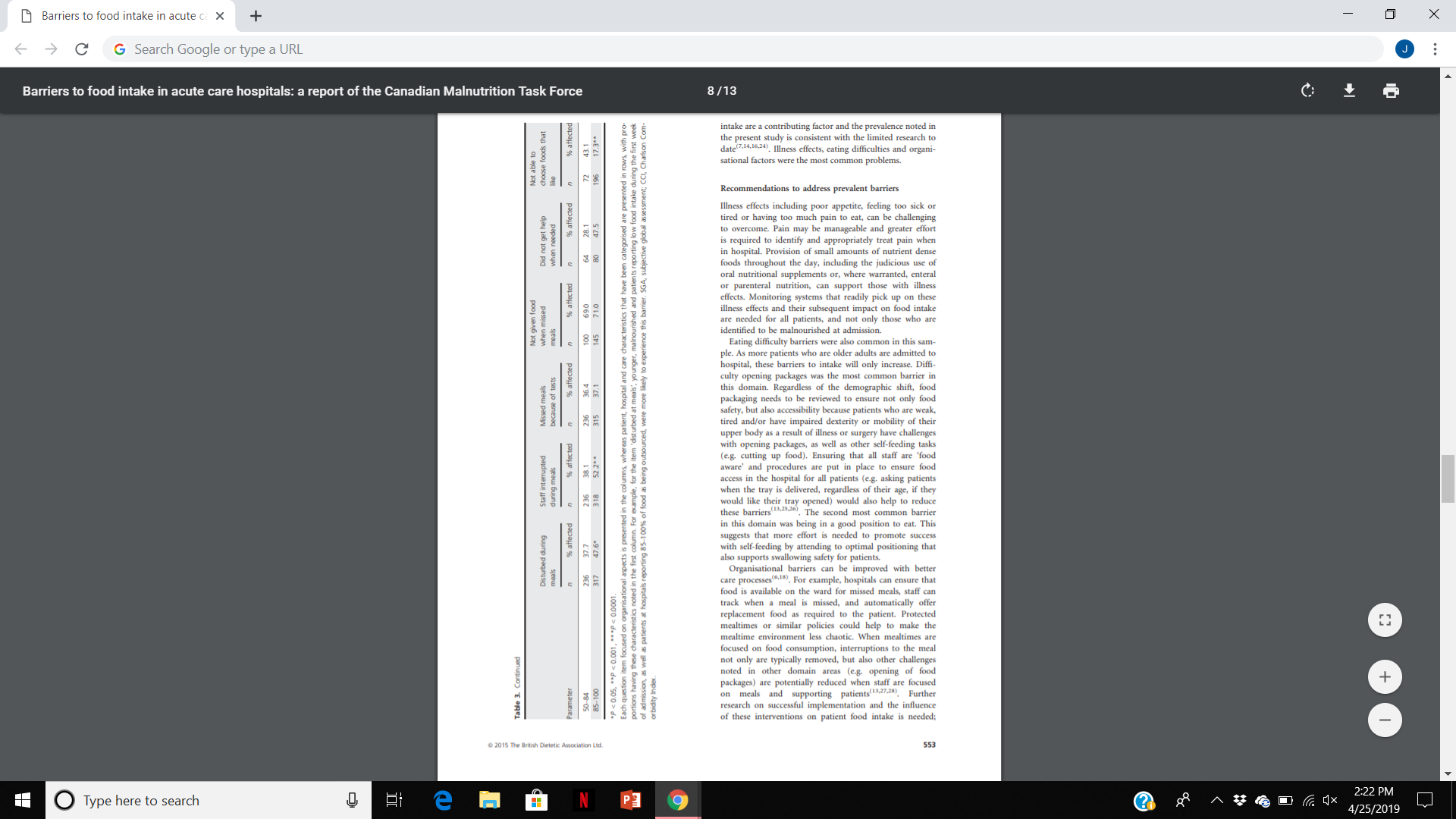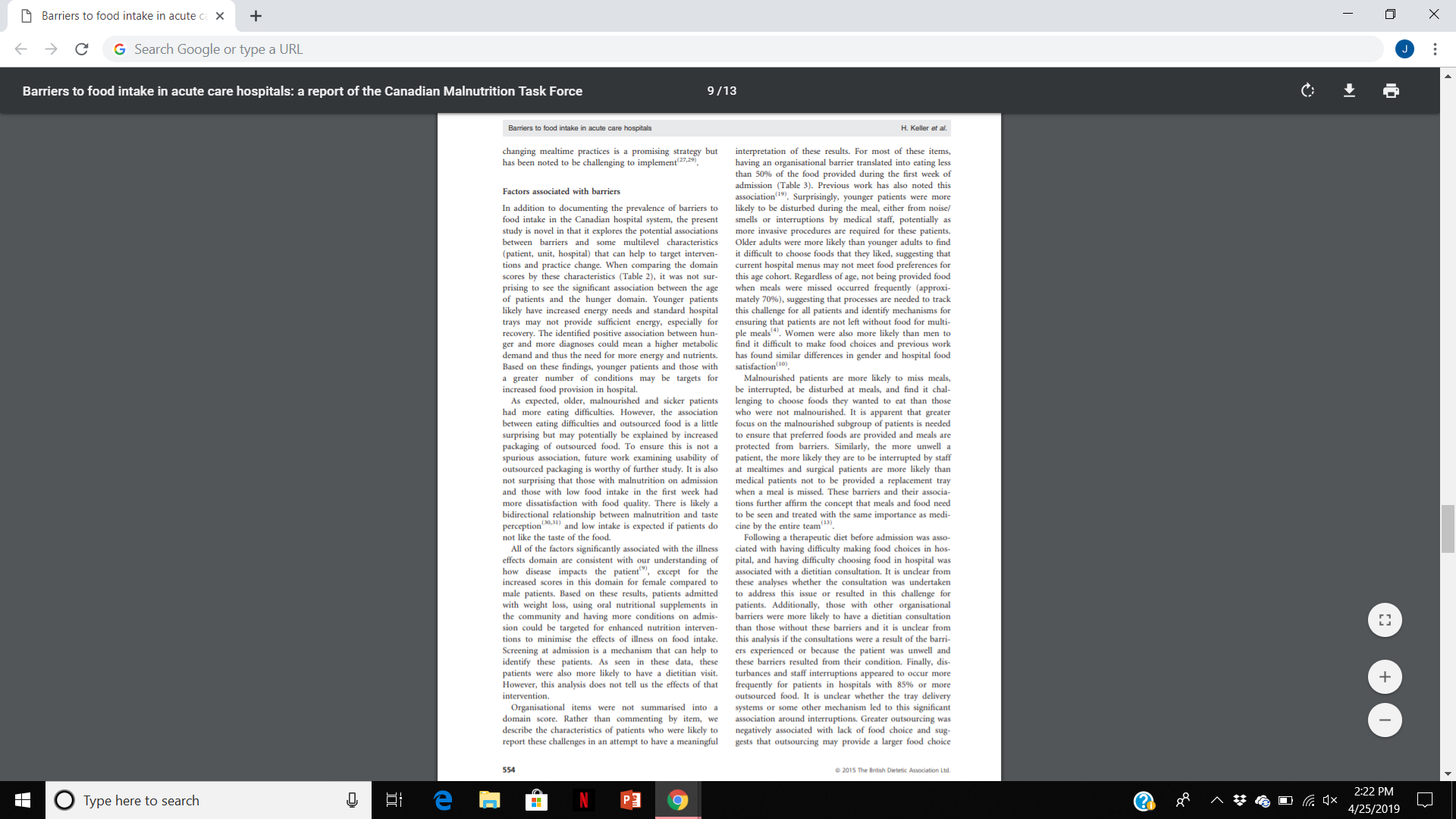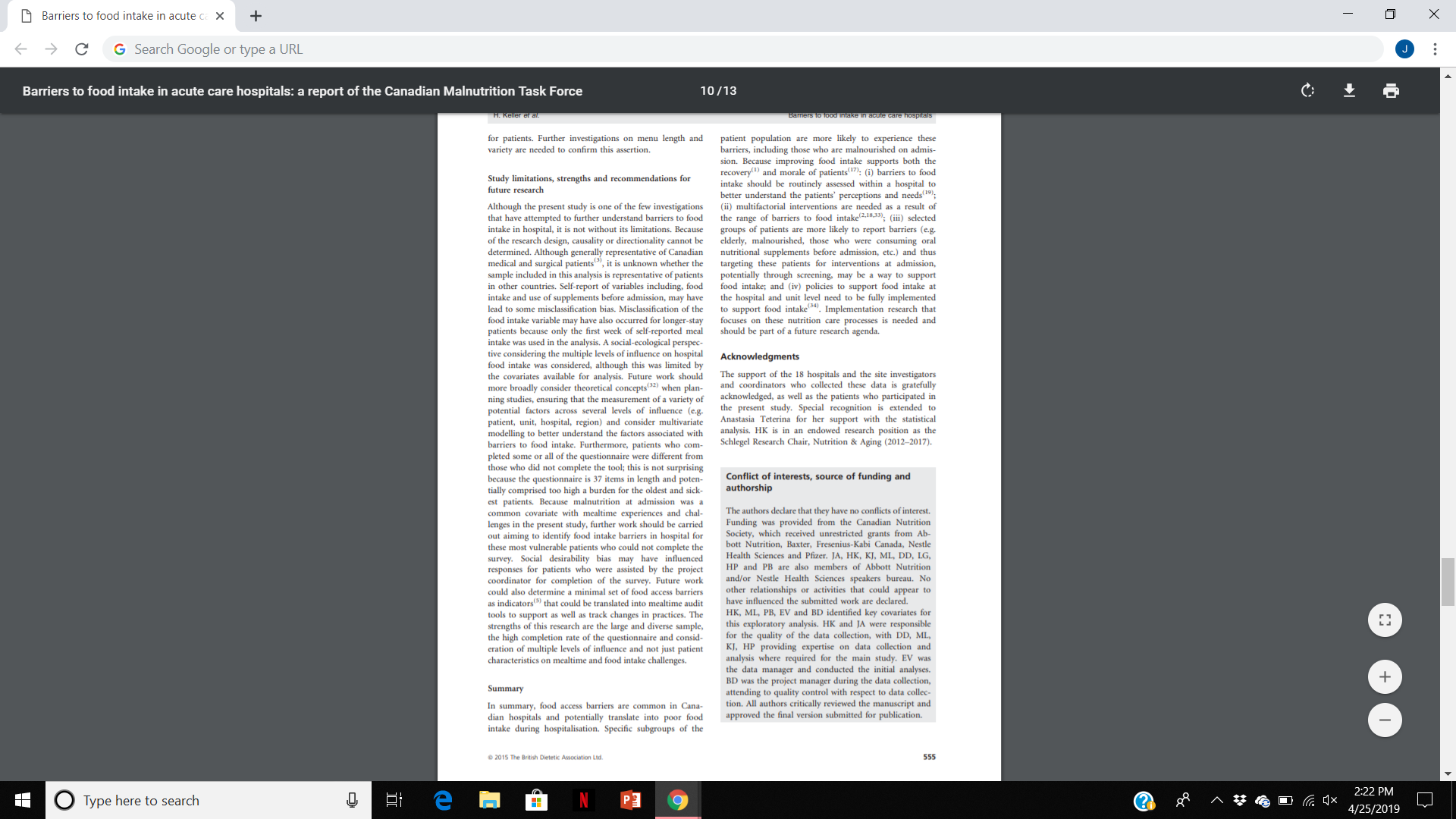Hello! I need help highlighting the 7 critical components in this article. They are as follows:
- source of funding
- researcher contact
- individuals studied and how they were selected
- nature of measurmets made or questions asked
- setting which measurements were taking
- differences in groups being compared
- magnitude of claimed effect
Barriers to food intake in acute ca X X -> C G Search Google or type a URL J : Barriers to food intake in acute care hospitals: a report of the Canadian Malnutrition Task Force 1/13 C: THE OFFICIAL JOURNAL OF THE BRITISH DIETETIC ASSOCIATION and Dietetics Journal of Human Nutrition and Dietetics CLINICAL NUTRITION Barriers to food intake in acute care hospitals: a report of the Canadian Malnutrition Task Force H. Keller, ' J. Allard,? E. Vesnaver," M. Laporte, L. Gramlich, P. Bernier," B. Davidson, D. Duerksen," K. Jeejeebhoy" & H. Payette 10 "Schlegel-UW Research Institute for Aging, University of Waterloo, Waterloo, ON, Canada Department of Medicine, University Hospital Network, University of Toronto, Toronto, ON, Canada "University of Guelph, Guelph, ON, Canada 'Reseau de Sante Vitalite Health Network, Cambellton, NB, Canada "Department of Medicine, University of Alberta, Alberta Health Services, Edmonton, AB, Canada "Jewish General Hospital, Montreal, QC, Canada Canadian Malnutrition Task Force, Canadian Nutrition Society, Toronto, ON, Canada "Department of Medicine St-Boniface Hospital, University of Manitoba, Winnipeg, MB, Canada "Department of Medicine St-Michael Hospital, University of Toronto, Toronto, ON, Canada QC, Canada "Centre de recherche sur le vieillissement, CSSS-IUGS, Faculte de Medecine et des Sciences de la Sante, Universite de Sherbrooke, Sherbrooke. Keywords Abstract dietetics, food service, malnutrition, meals, nutrition screening. Background: Poor food intake is common in acute care patients and can exacerbate or develop into malnutrition, influencing both recovery and Correspondence H. Keller, Schlegel-UW Research Institute for outcome. Yet, research on barriers and how they can be alleviated is lack- Aging, University of Waterloo, Waterloo, N21 3J1, ing. The present study aimed to (i) describe the prevalence of food intake Ontario, Canada. barriers in diverse hospitals and (ii) determine whether patient, care Tel.: 519 888 4567 or hospital characteristics are associated with the experience of these E-mail: hkeller@uwaterloo.ca barriers. Methods: Patients (n = 890; 87%) completed a validated questionnaire on How to cite this article barriers to food intake, including perceptions of food quality, just before Keller H., Allard J., Vesnaver E., Laporte M., Gramlich L, Bernier P., Davidson B., Duerksen D.. their discharge from a medical or surgical unit in each of 18 hospitals across leejeebhoy K., Payette H. (2015) Barriers to food Canada. Scores were created for barrier domains. Associations between these intake in acute care hospitals: a report of the barriers and selected patient characteristics collected at admissi Canadian Malnutrition Task Force. J Hum Nutr throughout the hospital stay and site characteristics were determined using Diet. 28, 546-557 bivariate analyses. doi: 10.111 1/jhn. 12314 Results: Common barriers were being interrupted at meals (41.8%), not being given food when a meal was missed (69.2%), not wanting ordered food (58%), loss of appetite (63.9%) and feeling too sick (42.7%) or tired (41.1%) to eat. Younger patients were more likely (P C G Search Google or type a URL J : Barriers to food intake in acute care hospitals: a report of the Canadian Malnutrition Task Force 2/13 C: H. Keller et al. Barriers to food intake in acute care hospitals Introduction the associations between these reported experiences and multilevel characteristics, including patient demographics, It is common knowledge that many patients are admitted disease and nutrition status, as well as hospital and care to hospital in malnourished states and that poor food traits. intake during hospitalisation exacerbates this condition, slowing recovery and affecting patient-related outcomes" ". However, food and meal services are generally under- Materials and methods valued in patient care's) and, if we are to change the outcomes associated with malnutrition in the hospital set- A multicentre prospective cohort study including 18 small and large (>200 beds), academic and community hospi- ting, we need to change the nutrition care culture, includ tals across eight Canadian provinces recruited 1022 adult ing the importance of mealtimes to the recovery of patients" ). One mechanism for starting the change pro- (218 years) medical or surgical patients over the period from August 2010 to January 2013 for the purpose of cess is by identifying areas for quality improvements characterising malnutrition, its determinants and its out- based on the patient's perspective"). Patient dissatisfaction with food service is a patient- comes. Sample size was calculated to provide a precise reported outcome's-10) that is associated with low food estimate of the prevalence of malnutrition considering the intake" ) and an increased length of stays.10). Yet, satis- clustering effect of hospitals; 60 patients from large hospi faction with the meal service does not fully capture the tals and 40 patients from small hospitals were recruited" Specially trained research coordinators used standardised food and mealtime experience in hospital; food intake is tools and protocols's) to minimise bias. This specific complex and influenced by the illness, as well as social, psychological and biological factors(6,7.11,12). Several quali- analysis is based on those participants who completed the patient food and meal times questionnaire. tative studies with patients or staff have described organi- sational and physical barriers to food intake(613-16) and entered into the study had an anticipated length of stay other studies have confirmed these challenges(17-19). One of at least 2 days, were proficient in English or French were not considered terminally ill at admission and con- of these qualitative investigations's) resulted in the devel- sented (or their family proxy) to participation. Patients opment of a standardised questionnaire to assess meal experience and food access barriers, including satisfaction who were admitted directly to the intensive care unit, obstetric, psychiatry, palliative or paediatric units, on with the sensory components of the meal; barriers were those who were admitted to a medical day unit, were summed into domains and were tested for internal con sistency and discriminant construct validity"". Despite excluded. Patients with terminal cancer or other condi tions identified at recruitment were also excluded. Partici- the acknowledged importance of barriers to food intake pants were recruited using a consecutive admissions in hospital and the availability of a quality measure for assessing these barriers and the mealtime experience, very protocol to avoid selection bias". Universities of Tor- onto, Guelph and Waterloo ethics reviews were com- little research focused on systematically measuring these issues and describing why they may be occurring has been pleted, as well as the research board review at each conducted. Specifically, quality indicators could be devel- participating hospital. A comprehensive clinical history was obtained by inter- oped) from this questionnaire and unit level strategies could target higher risk patients who are more likely to view and by accessing the medical chart; demographics of experience these barriers to food intake. Moreover, the age and gender were specifically used in this analysis, as well as pre-admission characteristics of self-reported routine use of a measure focused on identifying barriers to food intake could help to bench mark and change weight loss, use of oral nutritional supplements or follow- ing a therapeutic diet before admission. $ abjective global practices within individual hospital units. assessment (SGA) was used as the primary measure of The Canadian Malnutrition Task Force conducted a nutritional status, where SGA-B indicated mild or moder cohort study (2010-2013) in over 1000 patients from 18 ate and SGA-C severe malnutrition ."). Primary diagno hospitals across eight provinces. Part of this data collec tion included a validated patient food access question- sis, as well as any new diagnoses during hospitalisation + naire . Because this data collection included multiple and the presence/absence of cancer, was identified to cap- ture disease state. The number of diagnoses was used as levels (hospital, unit, patient), the present study provides covariate in this analysis. Charlson Comorbidity Index(22) an opportunity to understand more broadly the potential antibiotic use in the first 10 days of admission and high factors associated with various barriers to food intake. sensitivity C-reactive protein at baseline Thus, the purposes of this analysis are: (i) to describe e (categorised as ) were also used to demonstrate medical or surgical patients' reported experience of barri- acuity of the health condition. Every 2 days, site coordi- ers to food intake when in hospital and (ii) to explore nators reviewed chart notes and identified whether a O Type here to search 0 e N 2:21 PM Ed (? 4/25/2019 LJBarriers to food intake in acute ca X X -> C G Search Google or type a URL J : Barriers to food intake in acute care hospitals: a report of the Canadian Malnutrition Task Force 3/13 C: Barriers to food intake in acute care hospitals H. Keller et al. dietitian consultatio sons were based on a subset of participants as a result of the were estimated by patients or families present at the meal applicability of the item in question. For example, the barrier using the nutritionDay Form's21.24) for one meal on 3 days of the first week of stay and recorded as 0%, 25%, "did not get help when needed' was only relevant for patients who 'needed help with meals'. The primary analysis was to 50% or 100% consumption. These records were averaged determine associations among hospital, care and patient and dichotomised for analysis as 2 , CRP = 10 8 / 1 ) patients , as well as\\ hospital is high ( 4596) (` Nutritional status remains poor* or deteriorates throughout the hospital stay , whereas it* those who were in hospitals where a higher proportion of* improves in some patients ' " . Barriers that impair food* $ 2015 The British Dietetic Association Lid .\\ 551 O Type here to search \\PE ~`` [` `` HE'S-> O Type here to search Barriers to food intake in acute ca X -> C G Search Google or type a URL Barriers to food intake in acute care hospitals: a report of the Canadian Malnutrition Task Force 0 e 552 Table 3 Organisation ms associated with patient, care and hospital characteristics Disturbed during Staff interrupted during meals Missed meals Not given food because of tests when missed Not able to meals Did not get help choose foods that when needed like Parameter fected S ffected % affected % affected Age (years % affected 218 miers to food intake in acute care hospital Gender 33.9*** 67.6 70.6 45.6 20.7 25.9* 218 40.3 669 Male 37.5 28.6 Ed SGA at a 35.4 47.2 18.6* * Well nouris ed (A) Mild/moderate malnutrition (B) 35.8 688 217 Severe malnutrition (C) Number of diagnoses 50.0* 775 54.8 32.6* 2 Diagnose 69.0 35.3 23.2 3 Diagnose 36.4 31.0 28.9 CCI at admission 6.9* CCI s 2 373 CCI > 2 7 /13 C-reactive pro 39.6 41.2 170 21.7 27.1 C G Search Google or type a URL J : Barriers to food intake in acute care hospitals: a report of the Canadian Malnutrition Task Force EL/OL C: for patients. Further investigations on menu length and patient population are more likely to experience thes variety are needed to confirm this assertion. barriers, including those who are malnourished on admis- sion. Because improving food intake supports both the Study limitations, strengths and recommendat endations for recovery"") and morale of patients'17): (i) barriers to food future research intake should be routinely assessed within a hospital to better understand the patients' perceptions and needs(19). Although the present study is one of the few investigations (ii) multifactorial interventions are needed as a result of that have attempted to further understand barriers to food the range of barriers to food intake(2,18.35); (jii) selected intake in hospital, it is not without its limitations. Because groups of patients are more likely to report barriers (e.g. of the research design, causality or directionality cannot be elderly, malnourished, those who were consuming oral determined. Although generally representative of Canadian nutritional supplements before admission, etc.) and thus medical and surgical patients"", it is unknown whether the targeting these patients for interventions at admission, sample included in this analysis is representative of patients potentially through screening, may be a way to support in other countries. Self-report of variables including, food food intake; and (iv) policies to support food intake a intake and use of supplements before admission, may have the hospital and unit level need to be fully implemented lead to some misclassification bias. Misclassification of the to support food intake"". Implementation research that food intake variable may have also occurred for longer-stay patients because only the first week of self-reported meal focuses on these nutrition care processes is needed and should be part of a future research agenda. intake was used in the analysis. A social-ecological perspec- tive considering the multiple levels of influence on hospital food intake was considered, although this was limited by Acknowledgments the covariates available for analysis. Future work should The support of the 18 hospitals and the site investigators more broadly consider theoretical concepts"2) when plan- and coordinators who collected these data is gratefully ning studies, ensuring that the measurement of a variety of acknowledged, as well as the patients who participated in potential factors across several levels of influence (e.g. the present study. Special recognition is extended to patient, unit, hospital, region) and consider multivariate Anastasia Teterina for her support with the statistical modelling to better understand the factors associated with analysis. HK is in an endowed research position as the barriers to food intake. Furthermore, patients who com- Schlegel Research Chair, Nutrition & Aging (2012-2017). pleted some or all of the questionnaire were different from those who did not complete the tool; this is not surprising because the questionnaire is 37 items in length and poten- Conflict of interests, source of funding and tially comprised too high a burden for the oldest and sick- authorship est patients. Because malnutrition at admission was a common covariate with mealtime experiences and chal- The authors declare that they have no conflicts of interest. lenges in the present study, further work should be carried Funding was provided from the Canadian Nutrition out aiming to identify food intake barriers in hospital for Society, which received unrestricted grants from Ab- these most vulnerable patients who could not complete the bott Nutrition, Baxter, Fresenius-Kabi Canada, Nestle survey. Social desirability bias may have influenced Health Sciences and Pfizer. JA, HK, KJ, ML, DD, LG, responses for patients who were assisted by the project HP and PB are also members of Abbott Nutrition coordinator for completion of the survey. Future work and/or Nestle Health Sciences speakers bureau. No could also determine a minimal set of food access barriers other relationships or activities that could appear to as indicators's) that could be translated into mealtime audit have influenced the submitted work are declared. tools to support as well as track changes in practices. The HK, ML, PB, EV and BD identified key covariates for strengths of this research are the large and diverse sample this exploratory analysis. HK and JA were responsible the high completion rate of the questionnaire and consid for the quality of the data collection, with DD, ML, ration of multiple levels of influence and not just patient KJ, HP providing expertise on data collection and characteristics on mealtime and food intake challenges. analysis where required for the main study. EV was the data manager and conducted the initial analyses. + Summary BD was the project manager during the data collection, attending to quality control with respect to data collec In summary, food access barriers are common in Cana tion. All authors critically reviewed the manuscript and dian hospitals and potentially translate into poor food approved the final version submitted for publication. intake during hospitalisation. Specific subgroups of the 2015 The British Dietetic Association Lid. 555 O Type here to search 0 e N P 3 9 (? 60.x 2:22 PM 4/25/2019 LI
